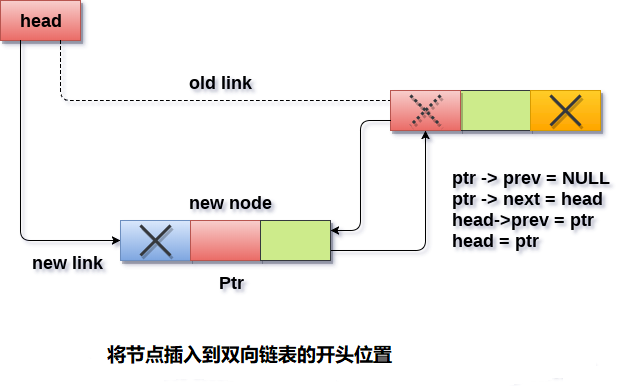在雙向連結串列開頭插入節點
2019-10-16 22:03:04
在雙向連結串列中每個節點都包含兩個指標,因此與單連結串列相比,在雙連結串列中儲存有更多的指標。
將任何元素插入雙向連結串列有兩種情況。 連結串列為空或包含至少一個元素。 執行以下步驟以在雙向連結串列的開頭插入節點。
- 在記憶體中為新節點分配空間。這將通過使用以下語句來完成。
ptr = (struct node *)malloc(sizeof(struct node));
- 檢查連結串列是否為空。 如果條件
head == NULL成立,則連結串列為空。 在這種情況下,節點將作為連結串列的唯一節點插入,因此節點的prev和next指標將指向NULL,並且頭指標將指向此節點。ptr->next = NULL; ptr->prev=NULL; ptr->data=item; head=ptr; - 在第二種情況下,條件
head == NULL變為false,節點將在開頭插入。 節點的下一個指標將指向節點的現有頭指標。 現有head的prev指標將指向要插入的新節點。這將通過使用以下語句來完成。ptr->next = head; head->prev=ptr;
因為,插入的節點是連結串列的第一個節點,因此它的prev指標指向NULL。 因此,為其前一部分指定null並使頭指向此節點。
ptr->prev = NULL;
head = ptr;
演算法
第1步:IF ptr = NULL
提示 「OVERFLOW」 資訊
轉到第9步
[結束]
第2步:設定 NEW_NODE = ptr
第3步:SET ptr = ptr - > NEXT
第4步:設定 NEW_NODE - > DATA = VAL
第5步:設定 NEW_NODE - > PREV = NULL
第6步:設定 NEW_NODE - > NEXT = START
第7步:SET head - > PREV = NEW_NODE
第8步:SET head = NEW_NODE
第9步:退出
示意圖

C語言實現範例 -
#include<stdio.h>
#include<stdlib.h>
void insertbeginning(int);
struct node
{
int data;
struct node *next;
struct node *prev;
};
struct node *head;
void main()
{
int choice, item;
do
{
printf("Enter the item which you want to insert?\n");
scanf("%d", &item);
insertbeginning(item);
printf("Press 0 to insert more ?\n");
scanf("%d", &choice);
} while (choice == 0);
}
void insertbeginning(int item)
{
struct node *ptr = (struct node *)malloc(sizeof(struct node));
if (ptr == NULL)
{
printf("OVERFLOW\n");
}
else
{
if (head == NULL)
{
ptr->next = NULL;
ptr->prev = NULL;
ptr->data = item;
head = ptr;
}
else
{
ptr->data = item;
ptr->prev = NULL;
ptr->next = head;
head->prev = ptr;
head = ptr;
}
}
}
執行上面範例程式碼,得到以下結果 -
Enter the item which you want to insert?
12
Press 0 to insert more ?
0
Enter the item which you want to insert?
23
Press 0 to insert more ?
2